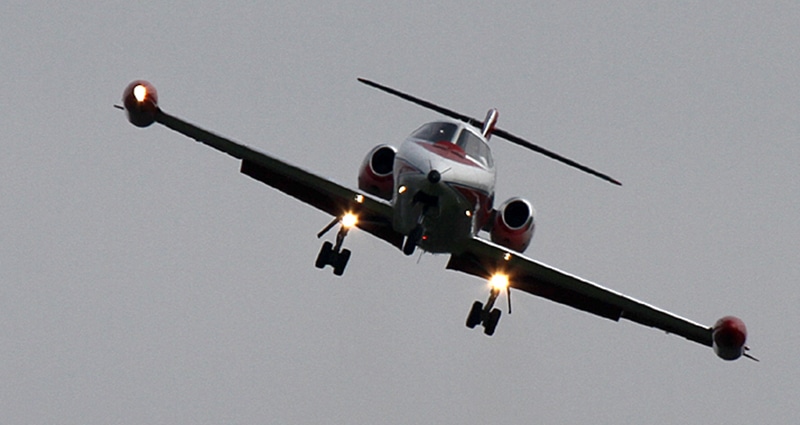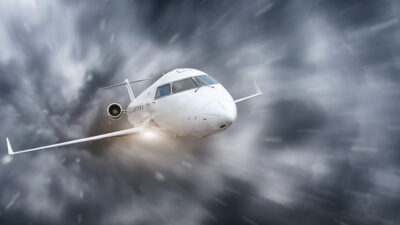Dutch Roll – Friend or Foe?

Merriam-Webster’s dictionary defines the Dutch roll as “a combination of directional and lateral oscillation of an airplane.” This would indicate that the Dutch roll is a very undesirable characteristic. After all, who wants oscillations in their aircraft, let alone oscillations in two axes at the same time? The FAA, in fact, treats recovery from the Dutch roll as an emergency procedure in those aircraft that have yaw damper requirements. The intent of this article is to point out that the Dutch roll mode is not all bad.
When a pilot pushes and holds the rudder pedals, for example in a crosswind correction, the airplane is flying in a sideslip. The airflow over the vertical tail tries to bring the aircraft back to straight flight and this is why the pilot has to hold the pedal deflection. In the flight test world we call this “directional stability.”
At the same time, the aircraft tends to roll in the same direction that the rudder pedals are being held. The reason an aircraft rolls when in a sideslip is primarily due to a characteristic called the dihedral effect. The dihedral effect can be created with geometric dihedral (an upward slope of the wing from root to tip), but can also result from wing sweep, or a high wing or T-tail. The roll created by the dihedral effect is a nuisance because the pilot didn’t ask for it.
If the pilot releases the rudder pedals from a crosswind correction, the aircraft will yaw and roll in an oscillatory manner until it damps out. This mode of motion was described by G.H. Bryan in 1911, and as early as 1916 was being called the “Dutch roll.” Note that even though these oscillations are caused by yaw (directional) stability, we do not even use the word “yaw” in its name. Instead, we call it the Dutch roll mode because the yaw response is usually accompanied by the unwanted roll response. The Dutch roll is not an aircraft deficiency but is the inevitable result of having directional stability, which we can probably all agree is a very desirable characteristic.
We sometimes refer to the Dutch roll mode as the “Dutch yaw” mode when discussing this with students at the USAF Test Pilot School. This is to emphasize that the Dutch roll mode is how we interact with the yaw axis of our airplane (through the rudder pedals) and is critical to yaw control. Unfortunately, a rudder input or other yaw disturbance will not only produce a yaw response, but it will also produce a roll response. The higher the dihedral effect, the more it will roll as it oscillates. To further aggravate the situation, the Dutch roll mode can be very lightly damped and its oscillatory behavior will be difficult to control.
Aircraft with extremely low yaw damping are a relatively new phenomenon, however, resulting from our quest for fuel efficiency at high speed and high altitude. That same quest often results in highly swept wings that create a significant dihedral effect, which when coupled with low damping, leads to a nasty
Dutch roll that is very difficult to control. Multiple yaw dampers are frequently incorporated so that the pilot doesn’t have to deal with it. But remember, the Dutch roll is how we control the yaw axis of the airplane, so whenever the pilot pushes the rudder pedal, the Dutch roll mode is excited.
So how can the Dutch roll be your “friend?” For normal flying, the rolling tendency of the Dutch roll is purely a nuisance and unnecessary for control. We use ailerons and/or spoilers for controlling the roll axis. However, what if you experience a failure in the roll axis, such as a complete loss of roll control, a hard-over roll control actuator, or complete hydraulic failure? In those situations, a well-trained pilot isn’t finished. By proper control of yaw, the pilot can regain control in roll through the “nuisance” roll component of the Dutch roll mode. Proper use of the rudder pedals as an alternate method of rolling an aircraft can mean the difference between recovery and loss of control.
Using the rudder pedals for roll control is not without risks, however, as evidenced by the well-known A300-600 accident in 2001. The Calspan Advanced Maneuver/Upset Recovery Training (AM/URT) program addresses this issue and pilots are able to safely learn and practice this technique in flight.
For more information about the AM/URT program, please contact your local Global Aerospace Representative.

Calspan Aerospace has been providing research and testing services in the aviation and transportation industries for over 70 years. Calspan’s Advanced Maneuvering & Upset Recovery Training (AM-URT) program provides the most genuine and technically advanced upset training experience available specifically designed for commercial jet pilots. Their curriculum is derived from real-world aviation accidents presented in a completely safe airborne simulation environment. Calspan’s training methods are based on 14 years of government and industry sponsored research and focus on the most effective upset recovery techniques. The training includes classroom instruction and in-flight training in unique Learjet In-Flight Simulators.
http://www.calspan.com/
© 2024 Calspan Aerospace. All Rights Reserved.
Next ArticleRelated Posts

Understanding the Challenge of Turbulence-Related Injuries in Business Aviation
The challenge of managing air turbulence in business and private aviation is becoming increasingly evident due to the growing number of turbulence-related incidents affecting aircraft operators across the industry.

Leadership, Management and Safety: Embracing Compliance and Conformance Oversight
Aviation operations, and by default, safety, are based on the idea that regulatory requirements are fundamental to establishing a framework to achieve safe operations.

